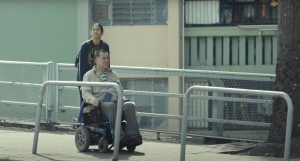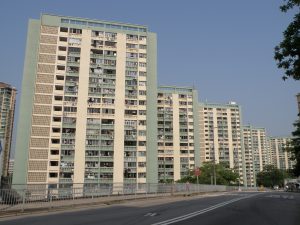STILL HUMAN, dir. Oliver Chan, 2018
Oi Man Estate, Ho Man Tin, Hong Kong

The movie “Still human” directed by Oliver Chan describes the touching story between Evelyn Santos, a Filipino domestic worker and Leung Cheong-Wing, who became disabled after a construction accident. The two first start off with a rocky start as they do not share a common language. However, their conflict begins to soften as Leung discovers Evelyn’s passion and dream about photography. Leung begins to support her dream as he realizes that she is trapped by her situation as he is and forced to face the reality. Some scenes take place in Central but a majority of the iconic scenes take place in Oi Man public estate.

Because the story takes place in the Oi Man estate, the atmosphere of the building mimics the character’s relationship with each other, either through the daily routines they perform or through lightings and or even cleanliness. The housing is presented to be ordinary, shown from the loud construction noises, cramped space and old interior. However, there is also a focus on the towering height of the building and the audacity of the apartment blocks, potentially showing Leung’s hopelessness, trauma and frustration in a metaphorical way. Moreover, the apartments are shown to be barred and the dark lighting further contributes to presenting Oi Man estate to have a gloomy atmosphere. Contrastingly, from the second half of the movie, the characters begin to pursue dreams and ideals, therefore, having a heavy emphasis on the sky that can be seen through the building, in a way indirectly showing a sign of hope. In the 1950s, Hong Kong faced an undersupply of affordable housing due to the tragic Shek Kip Mei fire and large waves of immigration from Mainland China. Therefore following the government’s public housing programme, the Oi Man estate was built in 1975 based on a concept of “a little town within a city”. Knowing this, in reality, the Oi Man estate would’ve served more as housing that is considered to be special and a symbol of hope to residents.


One of the most important messages that are present throughout the film is “anyone can dream” due to it being very closely related to other themes of the film such as dignity and respect. In order to maximise this importance of hope, the directors have chosen to look at the story from the residents of public housing or people who have lower social class compared to others. But the presence of the Oi Man estate goes beyond that purpose. The ordinary elements such as construction sounds, Lunar New Year decorations, and the way the characters talk and interact in the market are scenes that are observed by people every day, giving a sense of reality and humanism, making this story all lot more appealing to the audience. It also allows audiences to empathise and recognise Hong Kong’s social awareness of Filipino domestic workers and also the disabled by seeing a realistic experience or grievance they might face.

– Gayoung Kim (Rachel) 3035812165
References
- David. “Oi Man Estate in Hong Kong.” Randomwire, October 13, 2014. https://randomwire.com/oi-man-estate/.
- Lowe, Justin. “’Still Human’: Film Review.” The Hollywood Reporter, January 9, 2019. https://www.hollywoodreporter.com/review/still-human-1171939.
Your submission reads be a film analysis rather than a field report. It is unclear whether you have conducted the fieldwork as the only photo which is not a movie still seems to be from the internet of which the source should be properly acknowledged. You were asked to conduct an actual field work in order to make analytical observations and documentation. At present, there isn’t any first-hand insights which could have contributed to the comparison between the movie and the real. In your opinion, why did the director decided to pick Oi Man estate instead of other public housing estates in Hong Kong for the movie? Since you mentioned the everyday domestic spaces, it would be helpful to refer to Wojcik’s What Makes the Apartment Complex of L6 for further elaboration.